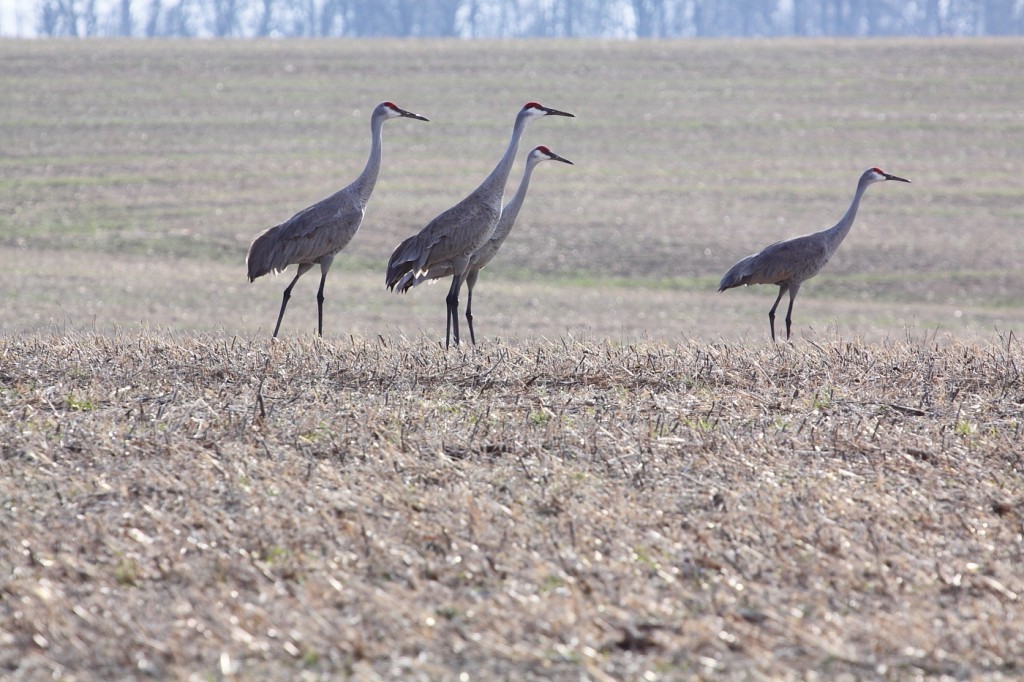Kentucky Afield Outdoors:
Sandhill crane season being considered
March 10, 2011 Contact Author: Art Lander, Jr.
FOR IMMEDIATE RELEASE 1-800-858-1549, ext. 4443
FRANKFORT, Ky. – The sandhill crane (Grus Canadensis) is a transient visitor to Kentucky whose numbers have increased dramatically since the 1970s. The eastern population is now conservatively estimated at about 60,000 birds.
The Kentucky Department of Fish and Wildlife Resources is considering a first-ever sandhill crane hunting season of the modern era with a harvest quota of 400 birds. Hunting could start as early as Dec. 15, 2011 and the season would run for 30 days.
“Persons drawn to hunt would have to successfully complete an online identification course,” said Rocky Pritchert, migratory bird program coordinator for Kentucky Fish and Wildlife. “There would be a two-bird limit per hunter, per season. Harvested birds would have to be tagged and telechecked (harvest reported by telephone).”

Adult sandhill cranes may be more than four feet tall, gray in coloration, with a tuft of feathers over their rump. They have a red forehead with white cheeks and a long pointed bill. They feed on grains in fields, but prefer to rest on the shallow mudflats of wetlands.
They are very mobile birds, capable of flying up to 400 miles a day at heights of up to 10,000 feet. When fully grown, they have a wingspan of six to eight feet. This helps sandhill cranes soar for hours in thermal updrafts, with only occasional flapping of their wings. In flight, their necks are held straight out with their long dark legs trailing behind.
Cranes may be the oldest known bird species surviving on Earth. Ten million-year-old fossils of cranes have been found in Nebraska. Cranes and herons look a lot alike, but are actually not closely related.
Sandhill cranes migrate through Kentucky twice a year along a corridor bounded roughly by Henderson in the west and Lexington in the east. In fall, the birds that stop over in Kentucky are migrating southward to their wintering grounds in southern Tennessee, Georgia and Florida. They come through Kentucky again as they migrate back northward to their breeding grounds in the Great Lakes states in spring.
“Sandhill cranes have a variable wintering range,” said Pritchert. “Some only migrate as far south as Indiana.”
Although most birds in the eastern population of sandhill cranes fly through Kentucky, the largest concentration of birds on the ground occurs in late winter at Barren River Lake, a popular wildlife viewing area.
“Kentucky is a return stop on the sandhill crane’s migration back to its breeding grounds,” said Pritchert. “Hunting activity in December and early January will not affect wildlife viewing opportunities in early February, when the largest number of birds stop over in Kentucky.”
Biologists believe sandhill cranes congregate at Barren River Lake because at winter pool the lake is drawn down 27 feet, from 10,000 surface acres to 4,340 surface acres, exposing thousands of acres of mudflats.
“They like to roost and loaf on the mudflats, and feed in agricultural fields as far as 30 miles from the lake,” Pritchert explained.
Major roost areas of Barren River Lake would be closed to sandhill crane hunting. “It’s a statewide season, but hunting success is expected to be very low, except in the fields around Barren River Lake,” said Pritchert.
There are several distinct populations of sandhill cranes in the U.S, three of which are already being hunted. The largest, the mid-continent population of sandhill cranes, which breeds in Canada and winters in Texas, has been hunted since 1961. Last season, 13 states in the western U.S. and three Canadian provinces had sandhill crane hunting seasons.
Decoying sandhill cranes into gun range is considered “the holy grail” of migratory bird hunting as sandhill cranes are extremely wary, with keen eyesight and an ability to spot unnatural looking decoy spreads.
Dates and bag limits for all migratory bird hunting seasons are reviewed by the flyway councils and approved by the U.S. Fish and Wildlife Service.
Sandhill crane hunting season recommendations for Kentucky will be discussed at the May 6 wildlife committee meeting, and the June 3 quarterly meeting of the Kentucky Fish and Wildlife Commission in Frankfort.
Author Art Lander Jr. has been writing about the outdoors since the 1970s. He is a staff writer for Kentucky Afield Magazine.
(Editors: Please email Lee.McClellan@ky.gov for photos.)
-30-
The Kentucky Department of Fish and Wildlife Resources manages, regulates, enforces and promotes responsible use of all fish and wildlife species, their habitats, public wildlife areas and waterways for the benefit of those resources and for public enjoyment. Kentucky Fish and Wildlife is an agency of the Tourism, Arts and Heritage Cabinet. For more information on the department, visit our website at fw.ky.gov.


wood like to know what camp sites are open in june
could you send me a email what camp sites are open in june an july